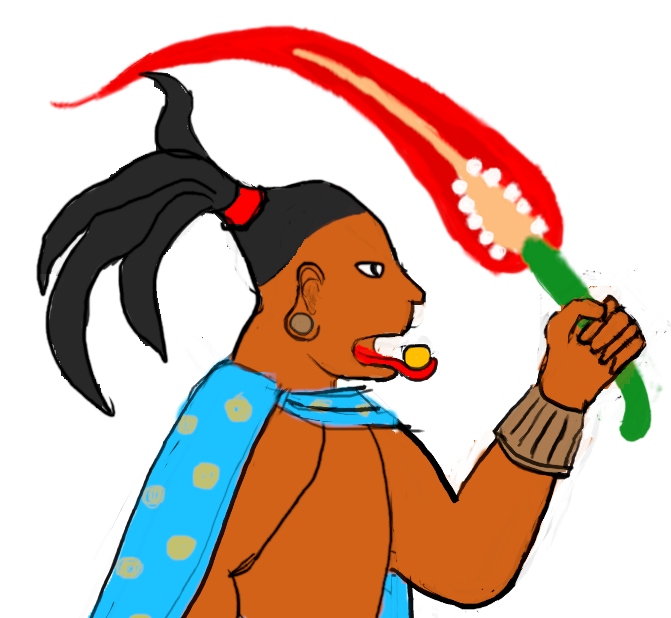Maronkis
General Knowledge
Maronkis is the language of the angels. It is a very musical language that many find pleasing to the ear. Interestingly enough, Maronkis literaly means "angel tongue." Maron is angel and Kis is tongue or language.However, there is some debate among the angels whether "kis" actualy means "tongue" or if it's referring to a literal tongue. Some also like to make the argument it's referring to a french kiss, but most angels don't think that's true.
Maronkis is a language that all angels speak not just The Messengers. (The Messengers have their own version of Maronkis.)Lettering
In Maronkis there are Belenmid (Bel-a-mid) and Vickatans (Vik-a-tanz), also called consanants and vowels, respectively, but along with these two types of letters, there is also one called the Shijon (She-ZHON). Shijons are mainly used in writing and are little marks, symbols, and occasionally swirls that indicate different things depending on the context and what the writer wants to convey. ]If a person is a speaker the way they use Shijon is using the inflections in their voice. It is similar to how English speakers go up in their voice to ask a question, even though it may not be phrased like a question. For example, "Hi?" Shijon is similar to that just more complex and used for much more than changing statements to questions.Writing System
The Maronkis alphabet or written langauge is called Calji (Cäl-jē). It consists mainly of characters with a spattering of letters. First, listed are the characters, then the letters. There is also an additional list for the Shijon, but that's memorized seperately. Calji is the overall name for the written language/alphabet. Then there are names for the characters and letters, as well as the Shijon. The specific name for the characters are Meshil (Me-shēl). The specific name for the letters are Doran (Dor-an), and Shijon is just called Shijon. This helps when talking about these three seperate parts of the written language.
Vocabulary
Phonetics
Main Sounds.
- The hard "C" sound.
- The "sh"sound.
- The French "zh" or "J" sound.
- The a soft "yoh" sound
- The "wuh" sound.
- Lastly, the "mah" sound.
Vackatan Sounds
- The "ooh" (u:) sound.
- The short "i" sound.
- The "ah" (a:) sound.
- The short "e" sound
- The AYE-yeh (ei-j) sound.
- The "ul" (ł) sound, a gutteral sound.
Belenmid Sounds
There are many Belenmid Sounds, so the ones I will mention are the silent ones, and special case ones (These aren't what they are actually called, but for the simplicity of explaining, I will do my best to translate. (Although there are not always English equivalents.)) Silent Letters- The letter "h". There is also no equivalent for the letter "h" in the Maronkis language.
- The letter Keron (Ke-ron) is silent.
- The letter "n" is usually silent, unless followed by a specific shijon, or a Sorrro, which is just a Maronkis letter.
- The "g" makes a "hu" sound.
- The letter "F" makes a "wh" sound, unless placed in front of a "h", then it makes a soft "b" sound.
- The letter combination "sd" makes a "sz" sound, unless it's placed after a "h" then it makes a hard "g" sound.
Shijon Sounds/Inflections
The inflections in Maronkis are rather simple. in writing the marks, symbols, or swirls are attached before, after, or in the word/statement/question to indicate which part goes up, is emphasized, or goes lower. When speaking you simple inflect your voice. The Shijon sounds are split into three different types the "mark" called Feyla (wei-lʌ), "symbols" called Simbelay (sim-bel-EI), and "swirls" called Ceryo (Seə-Jəʊ). Feyla are little marks that cause the voice to either go up or down.Feyla
There are two different types of Feyla that tell you whether to go up, down or stay the same. If the mark goes above the word you go up. If it's below the word you go down. If there is no Feyla on the word you keep the same tone.
The importance of Feyla is to differentiate between similar words. Words in Maronkis are spelled similarly, if not the same, therefore Feyla was created to differentiate between the words. Occasionally, some words have multiple Feyla, particularly longer words.
Simbelay
The next type of Shijons are symbols or in Maronkis Simbelay. Simbelay are something like characters. They are little pictures that will change the meaning of the sentence. Simbelay are more commonly used in writing. An example of this would almost be the comma, eg. After eating Grandma took a nap. In Maronkis there would be a simbelay after eating to show we are not eating Grandma. Simbelay are hard to use when speaking. If anything the symbelay are "translated" into breaths or pauses between words. "After eating *breath/pause* Grandma took a nap."Ceryo
Lastly, swirls or Ceryo. Ceryo are little curly q's or swirls off the end of a letter. These Ceryo tell whether to emphasize a word or not. When you emphasize something in Maronkis it tells the urgency of something. If you're emphasizing every other word, you are trying to say something very important. Note: when the letter "n" has a Ceryo attached to it, it will name a ñ soundTenses
Writing Tenses
Now, the debate is sparked in writing versus speaking Maronkis. The way to write something in the Payeh, Prasinta, or Takefh is by simply adding a Feyla. (Quick Review) Feyla are marks that specifically tell whether the voice needs to go up, down or stay the same, while Ceryo are swirls or curly q's that say whether to emphasize something. These "marks" are little curls before or after a character/letter that tell whether it is one of the three tenses. In summary, pronounced like Feyla, written like Ceryo. To write in Payeh, Prasinta, or Takefh. If the "Ceryo" is before the word it's Payeh or past. If it's after the word it's Takefh or future. If there is no "Ceryo" it's Prasinta.Sentence Structure
Heronkis also show respect if you're talking to the person. If they do not have higher status and are considered equal with you, you don't have to use Heronkis. If you're talking about yourself you don't use Heronkis either.
Sound Effects
In Maronkis there is something called Keronkis (Ke-RON-kis). These are used after the object. Keronkis are ways to describe an object without the need for other words. NOTE: Keronkis is extremely different from the letter Keron in the Maronkis language. Do not confuse them. Keronkis is atually sounds. These sounds are used when you want to describe something, but can't think of the words. Usually these are exclamatory sounds like "Wow" "Yeah" "OH" "OW" "WOOOH" (Granted some of them would be pronounced differently than how English speakers would, but many of them do sound somewhat similar)
Keronkis sounds have actually very specific meanings. Each of these sounds are used in different situations, so the person listening can understand. For example, if a person is trying to describe the majesty of a moutain, a Maronkis speaker could use several Keronkis sounds. He could use "WOW" (WŌ), or "AW" (Ô). Sometimes depending on how a person feels he could use a third, OOH (o͞o) (There is an unoffical rule that says you may only do a max of three Keronkis and even three is pushing it. Of course, it's unofficial so you could use as many Keronkis as you want).
Now, each of those named previously named (WOW, AW, and OOH) each have a specific meaning, or time to use them.
- WOW -- anything cool or impressive (This is one of the looser ones.)
- AW -- only used for something awe-inspiring (If used in any other context (eg. cute) it gets confsuing.*)
- OOH -- used when there is soemthing beautiful, occasioanlly someone very, very beautiful (usually for soemthing in nature eg. ocean sunset, majestic mountain, peaceful field etc.) *There are words and Keronkis that mean "cute" or "too cute to describe."
Adjective Order
Structural Markers
- The Peyod -- acts as the period; ends the sentence.
- The Merte -- acts as the question mark; tells the reader that the character or writer is asking something. Additional uses are 1) implying that something is not what it seems (eg. is the earth really flat? Is the tomato a fruit? Is space truly expanding?) 2) Used randomly in "angel literature" to misdirect the reader.
- The Uder -- acts as an exclamation point; when something is surprising and unexpected.
- The Gerbite -- acts as exclamation points; when someone is mad, expressig anger, or is shouting because it feels good. Note: The Uder and the Gerbite are and look similar, but the Gerbite is fancier.
- The Bifeda-- used when the ending mark can vary. (eg. "What?" or "What!") A second way, which is mostly used in slang is when there are more than two endings such as "Yes???"
Dictionary
- Spoken
- ' (apostrophe) go up
- xyz go down
- ~x means past tense
- x~ means future tense
Note: In the spoken phrases slur it together so it's almost one word. And sadly, written will not be appearing because Maronkis people mainly write in characters and that cannot be written here.
Hello -- Anyo (An-yo)
Good-bye -- Nokime (No-KI-me)
How are you? -- Ma ke jo ?(Ma ke zhô)
Good -- No'ki (NO-ki)
Thank you--Kerison' jo (Ke-ri-SÔN zhô)
What time is it? -- We' le refed' (We le re-whed) Literally 'What is time?'
Kill the living *name of god* out of you!--Gersam kerji' *name of god* ne jo! (ger-sam ker-zhe *x* ne zhô)
Why are you being weird?-- Wi' lei jo mo'jian? (Wi lay zhô mo-zhē-an) Literally 'Why are you weird/strange?'
Once upon a time...-- Anle' onadi refed'... (An-le on-adē re-whed...)





It's great to see that you've put so much effort into creating a detailed language. You might consider breaking up the longer sections of text with sub-headings and bullet points to make the information easier to read and digest.
Oh, thank you! I can't believe you actually read this. But thank you for your suggestions, and I will probably do that soon.